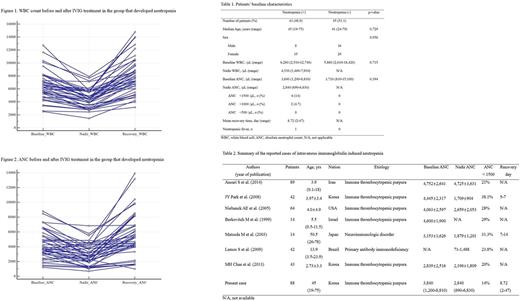Abstract
Background
Immune thrombocytopenic purpura (ITP) is an autoimmune disease in which anti-platelet antibodies accelerate the destruction of platelets. Traditional therapies such as steroid therapy, intravenous immunoglobulin (IVIG) therapy, and splenectomy generally reduce the peripheral destruction of platelets. However, they may cause significant side effects. In particular, it has been recently reported that neutropenia sometimes develops in children as an adverse effect after IVIG administration. On the other hand, there is no previous report on neutropenia developing as a complication of IVIG therapy in adult patients with ITP. The aim of this study was to further investigate the incidence and course of neutropenia following IVIG therapy in adults with ITP.
Methods
We performed a retrospective chart review of 88 ITP patients who had received IVIG to manage severe thrombocytopenia between January 2006 and March 2016 at Pusan National University Hospital in Korea. Inclusion criteria were the following: age ≥ 18 years, ITP diagnosis according to the American Society of Hematology guidelines (platelet count of less than 100 × 109/L in the absence of other causes or disorders that may be associated with thrombocytopenia). Exclusion criteria included other diseases known to be associated with ITP, such as human immunodeficiency virus or hepatitis C virus infection, lympho-proliferative disorders, thyroid or liver disease, and definite systemic lupus erythematosus. Patients included in this study had a complete and differential blood count performed before and after the IVIG treatment. Patients were treated according to a standard protocol, consisting of IVIG administration (1 g/kg per day for two days).
Results
The baseline characteristics of patients are shown in Table 1. Among 88 patients, 24 (27.3%) were male, and 64 (72.7%) were female. The median ages were 45 years in the group that developed neutropenia and 41 years in the group that did not develop neutropenia. The groups were comparable in age, sex distribution, initial white blood cell (WBC) count, and absolute neutrophil count (ANC). Neutropenia developed in 43 patients (48.9%) after IVIG treatment. In patients with a decrease in WBC count and ANC compared to baseline, median WBC count decreased from 6,280/μL to 4,530/μL after IVIG therapy, and median ANC decreased from 3,840/μL to 2,840/μL after IVIG therapy. Only two patients in this study developed a post-treatment ANC of less than 1,000/μL, and only one patient developed neutropenic fever, which subsided soon without any treatment. The neutropenia induced by IVIG had resolved spontaneously after several days, and the mean recovery time was 8.72 days after the completion of the IVIG treatment (Table 1, Figure 1 and 2). Including the present case, we identified previous reports of neutropenia developing as a complication of IVIG therapy in the English literature (Table 2). The majority of reports of neutropenia following IVIG therapy are pediatric patients with ITP. There were two reports on the incidence of neutropenia induced IVIG in adults except for pediatric patients with ITP. Matsuda M et al. reported neutropenia induced by high-dose IVIG in adult patients with neuro-immunologic disorders. And Lemos S et al. reported acute neutropenia in patients with primary antibody-deficiencies, after receiving IVIG. However, as mentioned earlier, there has been no reports of neutropenia following IVIG therapy in adult patients with ITP. Therefore, this study is the first report of neutropenia after IVIG therapy in adult patients with ITP. Although further studies are required in order to clarify the precise mechanism of neutropenia following IVIG treatment, this would be the important report of neutropenia following IVIG therapy in adult patients with ITP.
Conclusions
The results of this study suggest that IVIG may cause neutropenia commonly in adults with ITP, and it seems to be transient and self-limited. This study is meaningful as the first report that not only pediatric ITP patients may develop neutropenia post IVIG administration, but also adult patients suffering ITP. Therefore, an awareness of this common association of neutropenia following IVIG treatment in adult patients with ITP is likely to aid physicians in caring for these patients.
No relevant conflicts of interest to declare.
Author notes
Asterisk with author names denotes non-ASH members.


This feature is available to Subscribers Only
Sign In or Create an Account Close Modal